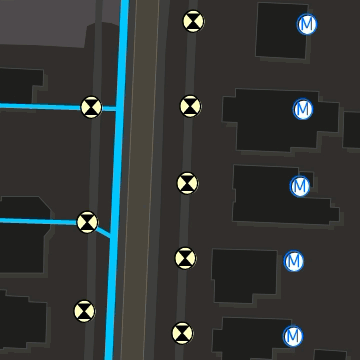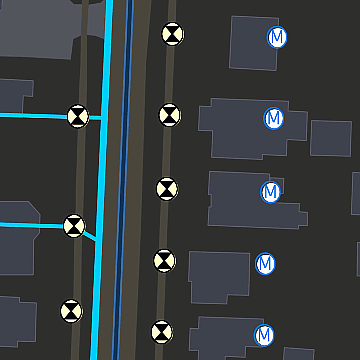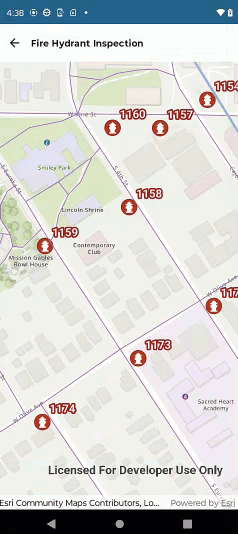This page provides details about enhancements in the 200.4 release of ArcGIS Maps SDK for Swift. It also lists deprecations, resolved issues, known issues, and more.
Enhancements
The following enhancements have been added with this release.
Editing
Snapping
The GeometryEditor now supports feature snapping when interactively creating and editing geometries. Snapping allows you to create geometries that connect and are coincident, so that interactive edits are more accurate, with fewer errors. When snapping is enabled in the SnapSettings, visual cues indicate to the user when edits have snapped to features. See SnapSource for information about configuring layers to be valid SnapSourceSettings.
Snapping can be used during interactive edits that move existing vertices using the VertexTool. It is also supported for adding new vertices for input devices with a hover event (such as a mouse move without a mouse button press).

Using the magnifier with a vertex move allows users of touch devices to clearly see the visual cues for snapping.

The snapping functionality provides one of a series of geometry editing enhancements that will roll out in future releases.
Attribute editing with feature forms
New to Native Maps SDKs in 200.4 is support for attribute editing using feature forms. Feature forms streamline the attribute editing experience across the ArcGIS ecosystem and are now supported in the .NET Maps SDK, Kotlin Maps SDK, and Swift Maps SDK. For more information about using the feature forms API, see the Edit attribute values topic in this guide.
A new toolkit component provides an out-of-the-box feature forms editing experience that you can integrate into your apps. For more information about the toolkit capabilities, see the FeatureFormView component in the Swift Toolkit API Reference.
The toolkit component provides a convenient way to add attribute editing capabilities to an app without writing a lot of code. It supports a variety of control types for accepting input attribute values, including single-line and multi-line text boxes, multiple choice controls (such as combo boxes and radio buttons), on/off switches, and a date-time picker control. These editing controls can be arranged and organized into groups and support custom Arcade expressions to control whether form controls are visible, editable, or require a value. Arcade expressions can also be used to compute the value for an attribute (perhaps based on the value of other attributes).

If you need a more tailored attribute editing UI and user experience, use the API to read the form definition from a feature layer in a web map and build a completely custom UI that fits your requirements. See the FeatureForm class for more information.
The following feature form functionality isn't currently supported: Editing the subtype field, attachments, relationships, and barcode input type.
Layers and display
Support for OGC 3D Tiles Layer
This release of ArcGIS Maps SDKs for Native Apps adds support for a new layer type OGC3DTilesLayer. The layer is based on the OGC specification for 3D Tiles. With OGC3DTilesLayer, you can add 3D Tiles data from a public service, portal item, or a local file that includes .3tz files. The layer behaves similar to ArcGISSceneLayer and can also participate in 3D analyses.
Clustering support for GraphicsOverlay
This release adds support for clustering point graphics on a GraphicsOverlay in dynamic rendering mode. In addition, there are new APIs to highlight an aggregate geoelement in a clustered FeatureLayer or GraphicsOverlay and get access to the underlying geoelements.
Dynamic entity track line rendering
With this release, track line attributes have been enhanced to include the entity ID attribute that uniquely identifies the track. This means you can now apply a renderer to trackLineRenderer in the TrackDisplayProperties that highlights or distinguishes between tracks using one of the attribute-based renderers.
Data and query
New field types
ArcGIS Maps SDKs for Native Apps now supports fields to store the following types of date and time values:
- Date only—Store values that indicate a day, month, and year. No time values are stored for date only fields.
- Time only—Store values that describe a moment in time (hours, minutes, and seconds).
- Timestamp offset—Store date and time values that include the time offset from the Coordinated Universal Time (UTC).
Big integer and 64-bit ObjectID fields are also now supported.
Date only - esri
Use a date only field to store data that was captured in the granularity of days or that represent an entire day, such as a date of birth, a hire date, a software release date, or a holiday. Date only fields store values in the format: YYYY-MM-DD (For example: 2024-04-10).
Query exact matches against the esri type using the DATE keyword along with a date value. These queries are in the format: field_name = DATE 'YYYY-MM-DD'.
For example: M.
Time only - esri
Use a time only field to store data that repeats daily or for information where only the time component matters, such as a daily meeting time, a store opening time, or a sunset time. Time only fields store values in the format: HH:MM:SS (For example: 18:30:55).
Query against the esri type using the TIME keyword along with a time value. These queries are in the format: field = TIME 'HH:MM:SS'.
For example: M
Timestamp offset - esri
Use a timestamp offset field for data where the local time value is important and the values can cross multiple time zones, such as events recorded in local time, airline departures and arrivals, or tracking product shipments. Timestamp offset fields store values in the format: YYYY-MM-DD hh:mm:ss ± OffsetFromUTC (For example: 2024-03-30T18:30:55-05:00).
Query against the esri type using the TIMESTAMP keyword along with a full ISO string. These queries are in the format: field = TIMESTAMP 'YYYY-MM-DD HH:MM:SS.mss ±HH:MM'`.
For example: M
Relative date and time queries
Relative date and time queries are now supported with all date fields (except time only) by providing the intervals in the query. Relative date queries can be performed relative to the current date or to a specified (anchored) date.
Query relative to an anchored date using this format: DateField >= AnchoredDate -+ INTERVAL 'IntervalValue' TimeStampFormat.
For example:
Date: Inspection
Timestamp offset: Inspection
Date only: Inspection
There are two main formats for queries relative to the current date or time:
<
<
For example:
Date: Inspection
TimeStampOffset: Inspection
Date Only: Inspection
You aren't limited to DAY for TimeStampFormat when using INTERVAL. Other values include HOUR, MINUTE, SECOND, DAY TO HOUR, HOUR TO MINUTE, and so on.
Utility networks
Support for shortest path traces while offline
ArcGIS Maps SDKs for Native Apps now supports the shortest path trace type for offline utility networks. This type of trace requires two starting points and a network attribute (such as shape length) and returns the shortest path based on the provided attribute. This means that utility networks with full topology from a stand-alone or sync enabled mobile geodatabase now support all of the trace types that utility networks from a feature service support.
Licensing changes
A Utility Network extension license is no longer required to analyze (trace) utility networks, and has been removed from these methods: UtilityNetwork.trace(), UtilityNetwork.queryNamedTraceConfigurations(), and Map.namedTraceConfigurations().
A new Advanced Editing extension license is now required to edit utility network features as well as create a version and edit features and tables in a branch version enabled feature service. This extension requires a minimum ArcGIS Runtime license level of Basic. Detailed information about the licensing changes made for ArcGIS Maps SDKs for Native Apps 200.4 and the specific methods that will require this license extension can be found in the License levels and capabilities topic in this guide.
Indoor positioning
Indoor positioning definition property on maps
An IndoorPositioningDefinition property is now exposed from the Map class. For an IPS-aware map, it provides all information needed to create an IndoorsLocationDataSource and conforms to the Loadable pattern.
New constructor for an indoors location data source
This release adds a new constructor to the IndoorsLocationDataSource that takes an IndoorPositioningDefinition. This provides a consistent and straightforward approach for creating an IndoorsLocationDataSource using IPS information stored with an IPS-aware map.
Indoors location data source configuration
An IndoorsLocationDataSource can now be configured using an instance of the new IndoorsLocationDataSourceConfiguration class.
Arcade
Support for Arcade 1.26
This SDK now supports Arcade 1.26
The following linear referencing functions have been added:
-
DefaultValue and HasKey have been updated to support checking nested dictionaries, arrays, and geometries.
Notes: Knowledge functionality which is available in Arcade version 1.26 with support in Pro and Online will be available in a future ArcGIS Maps SDKs for Native Apps release. The profile variables, $user and $graph, added to the PopUp and Popup Element profiles are currently set to null. A non-null $user implementation is planned for an upcoming release.
Projection Engine updates
Coordinate systems and transformations
Available coordinate systems and transformations have been updated to EPSG v11.003. These include the Equi7 projected coordinate systems, which divide the world into seven continental areas and are designed for imagery use. New vertical transformations based on geoids, quasi-geoids, or other conversion grids can transform to or between gravity-related vertical coordinate systems for the British Isles, Corsica (France), Finland, New Zealand, St. Helena Island, and the United States. The National Geodetic Survey's historic geoid models (GEOID99, GEOID03, GEOID06, and GEOID09) and VERTCON 3.0 conversion grids for the United States are now supported. Vertical transformations using VERTCON 2.1 grids are deprecated but remain available. Transformations using VERTCON 2.1 grids appear at the bottom of the list of transformation paths.
SDK enhancements
WorldScaleSceneView
WorldScaleSceneView provides an augmented reality world scale experience where ArcGIS Scene content is integrated with the real world. To learn more about using the World, see the WorldScaleSceneView toolkit tutorial.
App Privacy Improvements
A privacy manifest file with required reason API is now included with the Core framework. You can read more about these requirements in Apple's announcement on Privacy updates for App Store submissions.
Portal user properties
The following new properties are added to the PortalUser class: ID, available, and categories.
NetworkAuthenticationChallenge Enumerations
A new case reject has been added to NetworkAuthenticationChallenge.Disposition enum and a new case negotiate has been added to NetworkAuthenticationChallenge.Kind enum.
Breaking API changes
There are no breaking changes with this release.
Behavior changes
-
ArcGIS Pro 3.3 introduces the ability to define output fields (Reverse Output Fields) for reverse geocode operations. With locators created using ArcGIS Pro 3.3 and later, only fields enabled in Reverse Output Fields are returned from a reverse geocode operation in 200.4 and later. Supported output fields for geocode operations (including reverse geocode) are listed in the REST API under Geocode Service output fields. For locators created before ArcGIS Pro 3.3, reverse geocode results contain all output fields. In a future release of ArcGIS Maps SDK for Swift, all locators will only be able to return supported output fields in reverse geocode results.
-
Following the deprecation of VERTCON 2.1 and introduction of VERTCON 3.0 by National Geodetic Survey, vertical transformations using VERTCON 3.0 grids will now be returned from appropriate
TransformationCatalogcalls. Vertical transformations using VERTCON 2.1 grids remain usable and will still be returned fromTransformationCatalog.transformationscalls but will now appear at the bottom of the returned lists which are sorted by suitability. To make use of transformations using VERTCON 3.0 grids, the required grid files must be deployed with your app. These can be found in the Projection Engine Data download for this release. See the Projection Engine updates section for additional coordinate system and transformation enhancements introduced with this release.
Deprecations
API deprecations
- The method
fetchis deprecated onHome Page Featured Content Portalclass. - The properties
home,Page Featured Content Count homeandPage Featured Content Group Query showare deprecated onHome Page Description PortalInfoclass.
OS and framework deprecations
- Support for iOS/iPadOS 15 is deprecated. The last release to support this version is 200.4. A minimum of iOS/iPadOS 16 will be required at the next release.
- Support for macOS Monterey (version 12) is deprecated. The last release to support this version 200.4. A minimum of macOS Ventura (version 13) will be required at the next release.
Issues resolved
Issues addressed in this release are listed below.
Geodatabasemethods for managing transactions (beginTransaction(),commitTransaction(), androllbackTransaction()) have been made thread-independent. Any thread can end a transaction started by any other thread, integrating with modern language and platforms' concurrency models.
Known issues
Known issues or limitations for this release are listed below.
- BUG-000166643: A sceneview containing a scene with vector tiled layer can result in a crash if it's created and destroyed repeatedly. A possible workaround is to avoid using a vector tiled layer as a basemap, for example as an imagery basemap.
Changes in samples
New samples
- Add 3D tiles layer
- Add features with contingent values
- Augment reality to collect data
- Augment reality to navigate route
- Augment reality to show hidden infrastructure
- Configure basemap style parameters
- List spatial reference transformations
- Manage bookmarks
- Navigate route with rerouting
- Orbit camera around object
- Query features with Arcade expression
- Search for web map
- Set feature request mode
- Style point with distance composite scene symbol
- Style point with scene symbol
- Validate utility network topology
Enhancements
- Added the ability to identify favorite samples.
- Added Xcode previews to samples not using on-demand resources.
- Standardized toolbar usage and style across the samples.
- Renamed Add clustering feature reduction to a point feature layer to Configure clusters and Display points using clustering feature reduction to Display clusters to be more concise.
- Refactored the Generate offline map and Download vector tiles to local cache samples to correctly use view model.
- Updated the doc for the Show device location sample to better describe how to enable location services.
- Added a button to the top toolbar in the Mac Catalyst Sample Viewer so that you can open the specified sample on GitHub.
Bug fixes
- Fixed unresponsive toggles on Mac Catalyst in samples by removing custom Boolean bindings.
- Replaced the sliders with pickers in the Configure clusters settings pane to prevent cluster flickering.
- Fixed the animation in Animate 3D graphic so that the sample does not slow when you open a settings sheet.
- Set the minimum scale on the map in the Generate offline map and Download vector tiles to local cache samples to prevent large download requests.
- Disabled the "Union" toggle in the Create convex hull around geometries sample when there is no convex hull present.
- Replaced
EnvironmentwithObject Observedin samples when it was not required.Object - Updated the icons in the Find route in mobile map package sample to work in dark mode.
Related topics
- System requirements for 200.4
- Install and set up
- Display a map (Tutorial)
- Product Life Cycle (Esri Support Site)